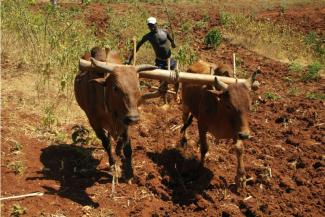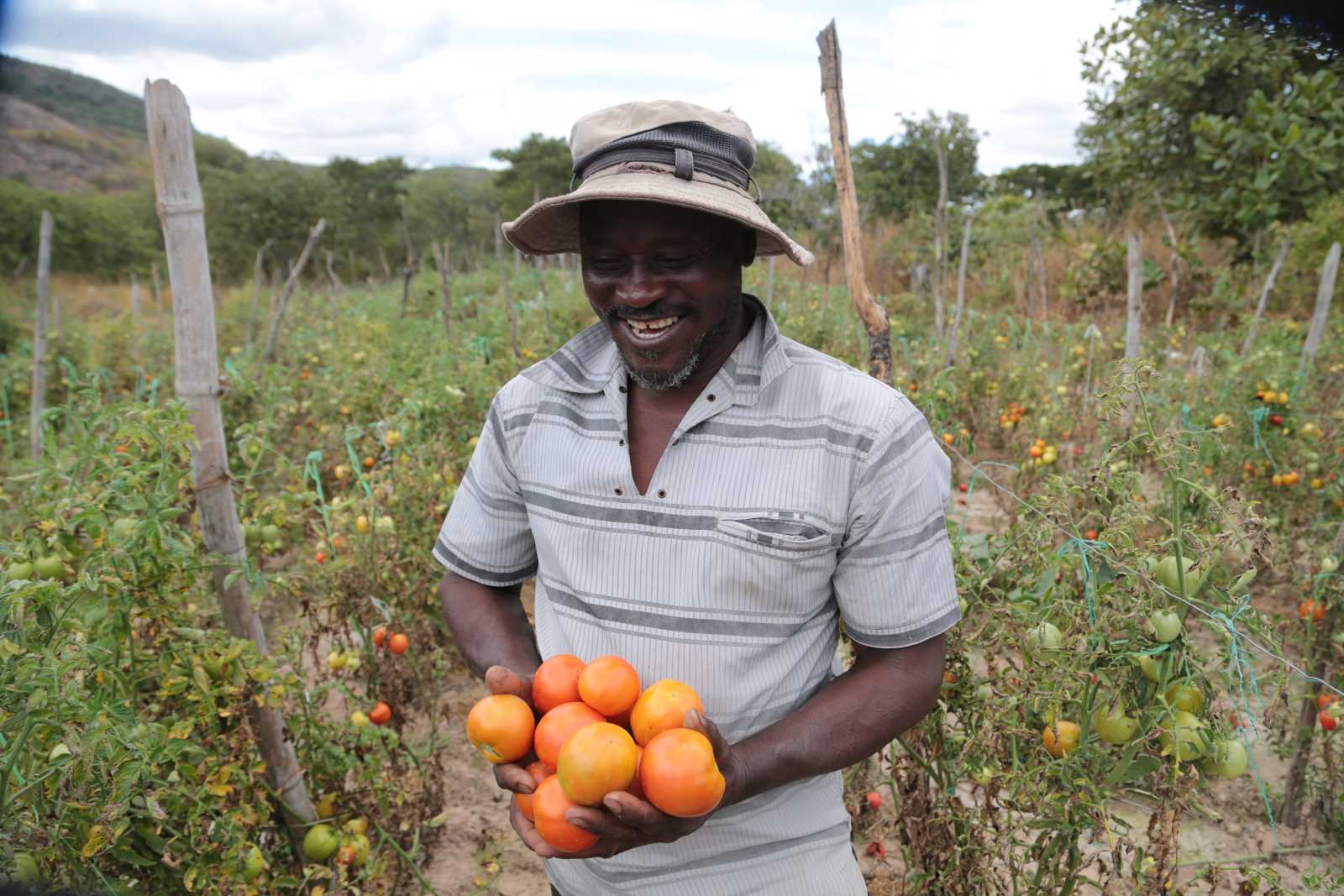Relevant reading
More organic farming in sub-Saharan Africa

To safeguard its own viability and feed the continent’s growing population, Africa’s smallholder agriculture needs much higher yields per hectare. At the same time, it must become more resilient to climate change and manage the natural resources more sustainable.
To date, conventional farm inputs such as high-yielding seed, mineral fertilisers and pesticides are not sufficiently made available to African smallholders, and all to often, they cannot afford what is on offer. Input use, moreover, involves inherent economic, environmental and health risks due to price volatility, climate impacts and lack of know-how. Accordingly, more domestically produced, organic fertilisers – such as manure, compost, mulch or cover crops – must be used.
It also matters that Africa’s natural resources are being depleted fast – faster than in any other continent. All natural resources like fertile soils, water, biodiversity, forests and pasture lands are affected here. Therefore, soil rehabilitation and sustainable resource management must be key priorities, apart from improving agricultural productivity.
Environmentally sustainable management
Development debate is currently focusing on several environmentally sustainable management systems for agriculture, which result in increased yields per hectare at the same time. The most discussed approaches in Africa are:
- sustainable intensification (SI),
- conservation agriculture (CA), and
- climate smart agriculture (CSA).
- In this essay, I will only consider the challenges they imply for small-scale farms.
- SI (Garnett, Charles, Godfray 2012) is only very vaguely defined as yields being increased “without adverse environmental impact and without the cultivation of more land“, but the terms CSA and CA are defined a little more precisely by the Food and Agriculture Organization (FAO 2013, 2014). Each of these concepts has three pillars. CSA aims at:
- increasing incomes,
- adapting to climate change and
- reducing greenhouse gases.
CA is specified as:
- minimum tillage/abstaining from using the plough,
- constant soil cover and
- crop rotation.
In principle, all approaches serve global needs, and they can be customised to specific regions. All ecologically sustainable systems aim to enhance the use of local inputs and stop or reduce the use of external inputs, such as mineral fertilisers or at least make their use more efficient for environmental as well as economic reasons. For achieving this, it is pivotal to boost the soil’s natural fertility by increasing its share of humus. This can be only done by enriching the soil with organic matter.
Organic soils are very useful in terms of adapting to climate change, moreover. They have a great buffer capacity concerning droughts and floods and withstand erosion. A side effect, moreover, helps to mitigate climate change because organic matter contains a lot of carbon. Soils are thus sequestration sinks for greenhouse gases.
The sustainable management approaches differ in their varying emphasis on individual elements. CA focuses on soil protection, especially by not using the plough. CSA focuses on adapting to climate change profitably, for instance by mulching; SI uses compost in order to reduce the need for mineral fertilisers. In practise, however, all the three approaches are often the same and serve to enrich the soil’s organic matter content.
Certification, yes or no?
There is no monitoring or certification system for the above-mentioned sustainable management approaches, so the smallholders concerned cannot demand higher prices for their products. Since one should not create a niche market for rich people in countries, where hunger and poverty are widespread, this scenario makes sense.
Without certification, however, there is no price incentive for small farmers to adopt sustainable farming methods. They will only adopt them if they are personally convinced, have other economic reasons or because they are involved in a project or support programme. This means there is a risk of sustainable methods being gradually abandoned, for example, as subsidies expire. Such dilution has indeed been observed in CA and CSA programmes and is subject of critical public debate.
In contrast, organic farming (OF) is the only method for which there are clear guidelines. Originally, the paramount goal was to produce healthy food free from chemical residues. But environmental awareness also mattered, and it still does. Organic farming is primarily about closing nutrient cycles, so the use of mineral fertilisers and pesticides is ruled out. OF associations monitor compliance. In turn, certification allows for higher prices than are paid for conventionally produced food stuff. However, in Europe the yields of organic farms are around 20 % lower on average than those of conventional ones. Higher prices make up for this yield difference.
In Africa, the prevalence of certified organic farming is still very low, only amounting to about 0.1 % (Hesse et al. 2009). It is almost exclusively limited to export production, because it can be monitored and certified, so European consumers will be willing to pay higher prices.
Whether organic farming is an option even without certification for Africa’s domestic markets is being discussed. On the upside, the yield differences between conventional and organic farming are smaller or even non-existent in Africa. Sometimes – and especially if the conventional reference system is weak, OF even leads to higher yields at lower costs (De Ponti 2012), so OF could be more profitable for small-scale farmers even if their goods do not fetch higher prices than those of conventional farms. Certification would become irrelevant.
Obstacles for organic farming
If this is so, then why is OF not much more popular in Africa? There actually are a number of obstacles. All sustainable cultivation systems essentially rest upon the build-up of organic matter in soils. Organic farming traditionally includes the utilisation of animal manure. In regions where cattle are hardly held, green manure, mulching, trees planting for agroforestry systems or composting can serve the purpose.
Building up organic matter is not simple however. It requires precipitation, because biomass is only built up when it rains. This is a huge challenge in many African regions with only one short rainy season. In temperate zones rainfall is spread over more time, so crops especially grown for enriching the soil fertility and ploughing under can be grown right after the main crop. This is not feasible in many African regions where short rains only allow for one crop per season. For these regions, another option is to plant trees and practise agroforestry. But to do this properly, one needs appropriate seeds, planting stocks, know-how and labour capacity, all of which tend to be in short supply. Moreover, the investment costs are quite high.
In Africa, animal manure typically accrues in too small quantities. Most farms only hold a few small ruminants, such as goats and sheeps, which are mostly kept without stables, so the manure would have to be collected all the time. Moroeover, farmers often lack means of transport, so they would have to distribute the manure manually on the fields, which takes a lot of time. In quantitative terms, it would be much better to apply bovine manure. However, only pastoralists, who do not belong to the same ethinic groups as the farmers, hold cattle in relevant numbers, and their relationship to farmers is mostly competitive. Reestablishing win-win situations in which crop farmers and pastoralists benefit from each others’ manure and plant residues would make sense, but it is very hard to do in the present political situation, in which tensions between different ethnic groups are growing.
Know-how and innovations
To sum up, all sustainable farming methods are hard to implement in sub-Saharan Africa – whether with or without certification. Often, additional labour will be needed, and innovations are necessary. Support is needed at several levels:
- suitable agricultural policies must foster sustainable land-management approaches and offer agricultural extension services that are competent in ecologically suistainable land management practises,
- research is still needed to identify the most suitable approaches for smallholders in different agro-ecological regions,
- loans and credits must be made available for means to transport manure and compost,
- farmers need devices for minimum tillage (as a substitute for the plough) and for mechanised weed control or even, in breach of orthodoxy, herbicides so they can reduce manual labour intensity,
- subsidies are needed for the acquisition of suitable seed (plant varieties and tree species), and
- targeted subsidies (e-vouchers) must promote soil enhancement.
In particular in places where soils are already degraded, sustainable methods will not be adopted widely unless they are supported by an appropriate agricultural policy. Ultimately, how strictly the systems are adhered to is only of secondary concern. The top priority is to work towards several goals at once, which are being more productive, more sustainable and resilient as well as profitable in very challenging conditions.
Susanne Neubert heads the Centre for Rural Develoment (SLE) at the Humboldt-University in Berlin.
susanne.neubert@agrar.hu-berlin.de
References
World Development Report, 2008: Agriculture for development. Washington.
http://siteresources.worldbank.org/INTWDR2008/Resources/WDR_00_book.pdf
Garnett, T., and Godfray, C., 2012: Sustainable intensification in agriculture. Oxford, UK.
http://www.fcrn.org.uk/sites/default/files/SI_report_final.pdf
FAO, 2014: Conservation agriculture (CA).
http://www.fao.org/ag/ca/
FAO, 2013: Climate-Smart Agriculture (CSA).
http://www.fao.org/docrep/018/i3325e/i3325e.pdf
African Ecological Footprint Report:
http://www.panda.org/lpr/africa2012
De Ponti, T., Rijk, B., van Ittersum, M., 2012: The crop yield gap between organic and conventional agriculture.
http://www.sciencedirect.com/science/article/pii/S0308521X1100182X
Hesse, M., et. al., 2009: Ökologischer Landbau und fairer Handel in Entwicklungsländern. Witzenhausen.
http://www.weltagrarbericht.de/fileadmin/files/weltagrarbericht/87943_Studie%20Oekolandbau%20Fairer%20Handel%20und%20Entwicklung.pdf















